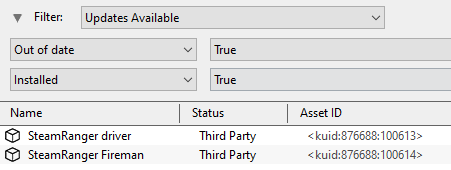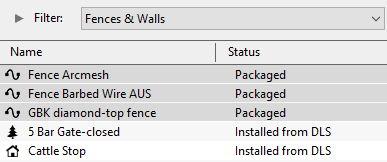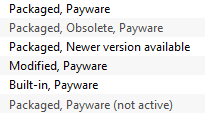The information in this Wiki Page applies to TRS19, Trainz Plus and TRS22. This page is intended to provide information for understanding the different asset Status labels used by Content Manager.
Content Manager Status
Start Content Manager by clicking Manage Content from the Trainz Launcher.
The Status column in the Content Manager display gives information about each listed assets location, availability, and its "currency" (installed, obsolete, modified, Payware, unknown, etc).
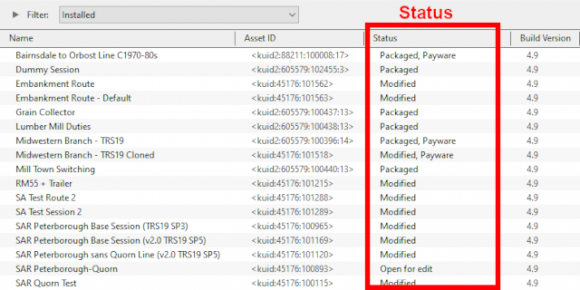 |
 |
If the Status column is not present in the Content Manager display, then:-
- right mouse click on the column heading where you want it to be inserted
- select Insert Column and then Status
 |
 |
Columns in Content Manager Can Be
Removed
- Right mouse click on a column heading and select Remove Column
Moved
- Hold down the left mouse button on a column heading and drag it left or right
Resized
- Move the tip of the mouse pointer onto the dividing line between two column headings, hold down the left mouse button and drag it left or right
|
|
|
|
 |
Notes:
It is important to remember that:-
 |
many assets on the Download Station (DLS) are available in more than one version, the original and at least one update. When an asset is updated by the release of a new version, the original, and any previously existing updates, will remain on the DLS for those who prefer to use them instead of the latest release. The status labels Newer version available and Obsolete are the result of updates. |
 |
an update will not always have the same name as the original or previous updates. It may also have a completely different Asset ID (or <kuid> code number) as shown in the examples below. |
| |
Example 1: the list below shows the same asset, the original and 3 updates, using 4 different names for the same <kuid> - the trailing :digit> is the update number.

|
|
|
|
Example 2: the list below shows the same asset, the original and 2 updates, all with the same name but each has a different <kuid>. The fact that they are updates of the same asset can be shown with the List Asset Versions command.

Assets with negative <kuids> can only be updated by issuing them with new <kuid> codes but this can also happen with any asset update.
|
|
|
|
 |
it is not uncommon for two completely different assets to have identical names. If one is not an updated version of the other then both will appear in the Surveyor asset selection lists and if they are of the same type, e.g. track, then they will appear under each other in the same selection list. |
|
| The Status labels are described in the following sections. |
Available for Download
 |
Available for Download simply means that the asset is on the DLS and is not already installed on your system |
The Status labels that you may see would include:-
|
|
 |
The Status label "Newer version available" means that a later version of that asset is also available and can be downloaded and installed |
 |
The Status label "Obsolete" means that a later version of that asset is already installed in Content Manager |
|
| Available for download |
This IS the latest version available on the DLS and it (this version) is not already installed. If you are looking to install a new asset or update an existing one to the latest version, then this is the one you would normally select |
| Available for download, Newer version available |
This is NOT the latest version available on the DLS and this particular version is not already installed. There is an update to this version available on the DLS |
| Available for download, Obsolete |
This is NOT the latest version available on the DLS and this particular version is not already installed. You have an updated version already installed but it may not be the latest version |
 |
You can check to see what is the latest version of an asset that is listed as Newer version available or Obsolete. This will produce a list of all the previous versions (installed or not), currently installed (if any) and later versions of the selected asset. |
| |
- right mouse click on the asset
- select the command List Asset Versions
The list can be sorted into alphabetical/numerical order using a particular column by clicking on the column heading.
- first click - sort ascending A to Z, 1 to 9, Jan to Dec
- second click - sort descending Z to A, 9 to 1, Dec to Jan
- third click - repeats first click, etc
|
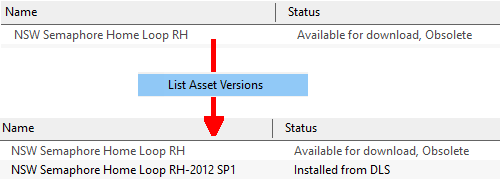
|
|
|
|
| |
In the example shown above the latest version of the selected asset is already installed (Installed from DLS) and it does not have exactly the same name as the original. If it is the latest available version and is not already installed then it will be shown as Available for download without any additional labels.
|
Create an "Available for Download" Filter
 |
This modified search filter will show all the freeware assets including their different versions that are available on the Download Station (DLS).
- Select the Content Manager search filter Download Station
- Open the filter (click the small triangle pointer on the left of the word Filter:)
- Remove (click the (-) buttons on the extreme right) of the filter lines:-
-
You can save this as a new filter
- Click the Save button (which will appear as soon as you delete one of the filter lines)
- Give the new filter a name (e.g. Available for Download)
Once saved you can reuse the filter whenever needed.
|
 |
|
|
Create an "Updates Available" Filter
 |
A very useful Content Manager filter to create and save is one that will identify and display any installed assets that have updates available on the DLS. Detailed step-by-step instructions for making the filter (it is a simple process) can be found on the Wiki Page  Using Content Manager to Update Assets but a summary is provided below. Using Content Manager to Update Assets but a summary is provided below.
|
Create a Custom filter as shown in the figure below:-

- Set the Installed filter line to True (it normally is)
- Change one of the remaining filter lines to Out of date and set it to True
- Delete all remaining filter lines
- Save the filter - "Updates Available" would be a good filter name
You can then highlight, right mouse click and select Download to get the updates for the selected assets.
Note: This will show but not update assets that are Built-in or Base.
- See the Wiki Page
 Using Content Manager to Update Assets for instructions on updating those assets. Using Content Manager to Update Assets for instructions on updating those assets.
|
|
|
Installing the Latest or an Older Version of an Asset
 |
To Install the Latest Version: You can select the version that is labelled Available for download with no other qualifier (Obsolete or Newer version available) or you can select ANY Available for download version (including those marked as Newer version available and Obsolete) and Content Manager will download and install only the latest version. |

In the figure above all the assets shown are different versions of the same original asset with the last entry the latest available version. |
- Select any version of the asset, it does not matter if it is labelled Obsolete
- Right mouse click on the asset and select Download
Content Manager will skip over any older but not yet installed versions and will download and install only the latest available version even if that version is not shown in your filtered list. |
|
 |
To Install a Specific Older Version: You can download and install an earlier (older or Obsolete) version of an asset if you don't want the latest version. |

In the figure above all the assets shown are different versions of the same original asset with the last entry the latest available version. |
- Select the specific version of the asset you want, it can be one labelled Obsolete which means that you already have a later version of the asset installed
- Right mouse click on the asset and select Download this Version
Content Manager will ignore any and all newer versions of the asset and will download and install only the selected version. |
|
Installed
This built-in search filter will show all the assets that are installed in Content Manager. Set the Content Manager search filter to Installed. The Status labels that you may see would be:-
[For simplicity only the major labels are shown in the figure below]
|
|
 |
The Status "Newer version available" added to a label means that a later version of that asset is also available and can be downloaded and installed |
 |
The Status "Obsolete" added to a label means that a later version of that asset is already installed in Content Manager |
 |
An asset that was originally Base, Built-in or Packaged can be changed to Installed from DLS by installing a newer version from the DLS |
|
| Modified |
The asset is one you have created yourself, modified or cloned from another asset or have installed from somewhere other than the DLS (e.g. a 3rd party web site) |
| Built-in |
The asset was installed when Trainz was installed on your system |
| Packaged |
The asset is included in a DLC package that you have installed. If the label Payware is NOT present then it is also available on the DLS. See the  Packaged and Payware section below Packaged and Payware section below |
| Installed from DLS |
The asset was installed from the DLS |
| Base |
The asset was installed when Trainz was installed on your system |
|
 |
Notes:
 |
You can delete assets that are labelled as Installed from DLS, Obsolete |
 |
You cannot delete assets that are labelled as Built-in, Obsolete or Base, Obsolete
|
|
|
|
Modified
You may often see the following label on installed assets:-
|
|
Modified
You have created, altered or cloned the asset, or not installed it directly from the DLS. |
This label will appear on all assets that you have:-
- created yourself (it will have your kuid code)
- modified from an installed asset
- cloned from an installed asset (it will have your kuid code)
- imported directly into Content Manager without using the Download command - as a result Content Manager will not know the source of the asset
Third Party
You may occasionally see the following label on installed assets:-
|
|
Third Party
The assets availability is "questionable". It may be best to avoid using until its status is resolved. |
This will appear on assets that:-
- you have uploaded to the DLS but they have not yet been approved for distribution. Usually it takes 24 hours (sometimes more) before approval is given. After approval the Third Party label will be changed to Installed from DLS
- have been removed from the DLS listing, for a variety of reasons:-
- if the reason was copyright violation then the assets will no longer be available to anyone who had not already downloaded and installed them before they were removed. If you had downloaded them before their removal then they will appear as Third Party in your Content Manager. If you include them in an uploaded Route then they will appear as <unknown assets> in the Content Manager of users who have downloaded your Route but do not already have the assets.
- if the reason is repair work then they can still be downloaded and installed, as Third Party assets, and the repaired assets will (eventually) become available as updates that will be identified using the "Updates Available" filter as shown in the example below.
- in some circumstances a removed asset might still be downloaded as a dependency of another asset but not as an individual asset in its own right. It will receive the label Third Party once downloaded.
Disabled
You may occasionally see the following label on installed assets:-
|
|
Disabled
The asset has been manually Disabled (from the Content menu select Disable). |
Disabling assets will "hide" them from other assets, including Routes and Sessions, so they cannot be used. It is a useful technique for deleting troublesome assets from a Route or Session without actually deleting the assets themselves.
- For an example of this see the Trainz Wiki Page at
 Deleting Stubborn Scenery Assets.
Deleting Stubborn Scenery Assets.
Normally you would restore the Disabled assets after fixing the Route or Session (from the Content menu select Enable).
Payware assets that are Disabled will have Payware (not active) as their status label.
Open for Edit
|
|
Open for edit
The asset is currently in use by another process such as Surveyor, Driver or Content Manager. |
This label will appear on any asset that you have:-
- currently open in Surveyor (a Route that is being edited) or Driver (a Session that is running)
- opened in Content Manager for editing - for example changing its config.txt file or image files
- imported into Content Manager from a Content File (.cdp file) or a Content Folder when the same asset is already installed
In the first case, exiting Surveyor or Driver will close the open Route and Session assets.
In the second and third cases you will need to manually close the open assets.
|
To manually close open assets:-
- select the open assets (individually or as a group)
- right mouse click on an open asset
- select the Submit Edits command to close them with the edits saved, or
- select Revert to Original to cancel the edits and return the assets to their previous unedited states, or
- select Revert if Unchanged if you have opened the assets (in Explorer or have just viewed their config,txt files) but have made no changes. Any opened assets that you have changed will remain Open for Edit
|
 |
|
 |
Notes:
 |
Assets that are Open for edit cannot be exported to a .cdp file or uploaded to the DLS. They must be closed first |
 |
If you import assets into Trainz from a Content File (.cdp) or a Content Folder then Content Manager will not search for and install any missing dependencies from the DLS. You will have to do this manually. See the  Missing Dependencies section below Missing Dependencies section below |
 |
If Trainz unexpectedly closes while using Surveyor or Driver, such as a Crash To Desktop or it is terminated by Windows Task Manager, then the loaded Route and Session will be Open for edit when you restart Trainz.
- See the Trainz Wiki Page
 Route and Session Basics for more information on dealing with this situation Route and Session Basics for more information on dealing with this situation
|
|
|
Unknown, Incompatible, Not Installed
Set the Content Manager search filter to All Content and click the Status column heading (once or twice) to sort the very long list according to their Status labels. Scroll down the list and you may see:-
Unknown Location
 |
The Status label "Unknown location, Obsolete" means that a later version of that asset is already installed in Content Manager |
|
|
Unknown location
The asset is listed as being on the DLS but it is unavailable |
The Unknown location label can sometimes appear if a later version of an asset has been uploaded to the DLS but the original version was not or had been removed for some reason, as shown in the example below.
 |
If the asset is simply labelled as Unknown location then try the following:-
- right mouse click on the asset
- select List Asset Versions
You may find a later version is Available for download

|
|
Incompatible
|
|
Incompatible
The asset is designed for a more recent version of Trainz than you are currently using. |
For example: The SP4 versions of TRS19 and Trainz Plus will load Routes and Sessions with asset build numbers up to and including 4.9. Routes and Session with build numbers 5.0 and above will be labelled Incompatible and will need a later Trainz version (for example TRS19 SP5 or TRS22 for build 5.0) to be loaded.

The Build Version column will identify the minimum Trainz build that the asset needs.
 |
To display the Build Version column in Content Manager:-
- right mouse click on any column heading where the new column will be inserted
- select Insert Column and then
- select Build Version

A list of all the Trainz Build Version Numbers with their corresponding Trainz Version Names and service pack (SP) numbers can be found on the Trainz Wiki Page at  "Trainz-build"_number "Trainz-build"_number
|
|
Not Installed
|
| Not installed, Payware (not active)
The asset is in a DLC package and must be installed using the Content Store option from the Trainz Launcher |
This status label can appear if you uninstall a DLC package (e.g. a Route) that you have modified or cloned as a new asset. Most Payware assets can be modified but conditions apply. See the section  Modifying and Sharing Payware below.
Modifying and Sharing Payware below.
Unknown Asset
An <unknown asset> can appear when using the List Asset Versions or the List Dependencies commands on a selected asset.
The label "<unknown asset>" will be shown in the Name column and the Status column will be blank.
|
|
unknown asset
The asset cannot be found on your system or on the DLS. |
| Using the List Asset Versions command on a selected asset will often reveal one or more unknown assets. |
 |
In this example:-
- the first version of the asset (<kuid:122285:1161>) is also the original version and is available on the DLS but it is now Obsolete as a later version is already installed
- the fourth and latest version (<kuid2:122285:1161:3>) is labelled as Packaged and is installed in Content Manager. It is also available on the DLS
|
The two intermediate versions (:1 and :2) are unknown assets and are not available on the DLS. They may have been created but never uploaded. It is not unusual for asset creators to leave "gaps" in the Asset ID update numbers (the trailing ":digit" in the <kuid>) during the development process.
If the two unknown assets shown above had been uploaded to the DLS then they would have been made Obsolete by the latest version.
|
|
|
Apart from the example above, unknown assets are almost always dependencies of other assets that you have downloaded and installed. The installed assets would be labelled has having Missing dependencies. See the  Missing Dependencies section below.
Missing Dependencies section below.
|
 |
Note:
Having an <unknown asset> is not necessarily a problem. If an installed asset with an unknown asset as a dependency is not classified as Faulty then it can often be ignored. A Route, for example, can be labelled as having unknown assets but still function perfectly well.
|
|
The unknown asset may:-
- be from an independent (3rd party) web site
- have been made by the same creator as the dependant asset but was not uploaded to the DLS
- have been removed from the DLS for some reason (a rare event but it does happen)
- simply not exist, anywhere
Fixing this may not be easy. Possible solutions are:-
- There is a very long thread in the Trainz Forum where you can find posts looking for missing/unknown assets. See
 Missing kuids? Post them here
Missing kuids? Post them here
- You can try contacting the creator via email (their address may be in the config.txt file) or a PM (Personal Message) through the Forum
Neither is a guaranteed solution.
If the unknown asset is in a Route or a Session then a third option is to use the Delete Missing Assets command from the Tools menu in Surveyor, but make a backup copy of the Route or Session first.
Packaged and Payware
 |
Packaged assets are found on the DLS as well as in DLC packages |
 |
Payware assets are exclusive to DLC packages |
 |
DLC packages can only be installed, updated and uninstalled using Content Store from the Trainz Launcher |
 |
Notes:
All new DLC packages downloaded and installed from the Content Store now contain ALL the required dependencies in the download package. This includes any assets that are on the DLS or on independent web sites that in the past would have to be downloaded separately from the DLS or elsewhere.
- If you already have the exact same version of an asset that is included in a package you are installing then you will NOT end up with two identical copies of that asset. Your installed copy of the asset will be re-labelled as Packaged.
- If the version included in the package is more recent than your current version then the newer version will be installed and the previous version will become Obsolete - this is the normal process for asset updates.
Problems can arise if the asset included in a DLC package has a higher version number (the :digit> at the end of a kuid2 number) than the copy on the DLS. This usually occurs when the DLS copy has not been updated to match the DLC copy. See How to Check the DLS Status of Packaged Assets below. If you encounter this problem in a Packaged asset, report it by the Bug Reporting Web Page or the Trainz Help Desk
|
|
 |
WARNING:
If you Uninstall a DLC package then all its Packaged assets will be deleted, even if those same assets were previously labelled as Installed from DLS. Content Manager has no way of "knowing" if an asset was previously Installed from DLS or was originally installed from the package itself. This could result in other installed assets becoming faulty due to Missing dependencies.
The solution is to run a DBR (Database Repair) after the Uninstall then redownload the missing assets from the DLS. See the Wiki Page  How to Perform a DBR for more details. How to Perform a DBR for more details.
|
|
Some of the Status labels that can appear on Packaged and Payware assets are:-
|
|
 |
The Status label "Newer version available" means that a later version of that asset is also available and can be downloaded and installed |
 |
The Status label "Obsolete" means that a later version of that asset is already installed in Content Manager |
 |
An asset that was originally Packaged or Payware can be changed to Installed from DLS if an update is installed from the DLS. It is possible for a Payware asset to be replaced by an updated "Freeware" version, |
|
| Packaged |
The asset is included in a DLC package that you have installed. See Notes: below |
| Payware |
The asset is part of a payware package (usually from the DLC). Most DLC Payware can be modified and it is even possible to upload Modified, Payware assets to the DLS but special restrictions will apply. Exactly which assets in a package are Payware and which are Packaged is decided by the creator of the package. See the section  Modifying and Sharing Payware below Modifying and Sharing Payware below |
| Payware (not active) |
The asset is part of a payware package that is no longer active on your system. You may have uninstalled the package, disabled it, or it may have been installed for a free trial period which has now expired |
| Packaged, Payware |
The asset is encrypted so it cannot be modified or cloned |
| Modified, Payware |
The asset is Payware that you have modified or cloned with certain restrictions. See the section  Modifying and Sharing Payware below Modifying and Sharing Payware below |
 |
If a Payware asset has the label Newer version available and no update can be found on the DLS, then open the Content Store (from the Trainz Launcher) and select the Updates option to check for any updates to the installed DLC packages |
|
Modifying and Sharing Payware
It is possible to modify a payware route and upload it to the DLS provided the creator of the route allows this to happen. There are some conditions that apply:-
- If the status of a route is listed as "Packaged, Payware" then the route has been encrypted and cannot be modified or cloned
- You can modify and save an unencrypted payware route that is installed on your system. It will be saved as an alias of the original and, provided the original payware route remains on your system (i.e. it is not deleted or disabled), then your modified copy will work
- You can upload a modified payware route to the DLS (again, if the route creator allows this) for others to download and use but they must also have the original payware route installed on their system
- It is NOT possible to merge a payware route with another route (payware or freeware) as this will remove the payware protection from the route
 |
WARNING:
If you uninstall or disable the original payware asset then your cloned or modified copy will no longer work. The original DLC payware asset must be present and active in Content Manager for your copy to work.
|
|
 |
What happens to my modifications if the creator of the original payware route issues a new update?
If the update is issued by the normal method, as an increase in the build number (the trailing :digit> at the end of a kuid2 number) then your modifications should not be affected.
If, however, the content creator has released the update with a completely new <kuid> number then your modifications will most likely not work.
In either case, if your modified payware route no longer works after an update to the original payware then report the problem by the Bug Reporting Web Page or the Trainz Help Desk
|
|
Using Packaged Assets in Routes or Sessions Uploaded to the DLS
 |
Packaged assets can be used in routes and sessions that you upload to the DLS |
An asset will be labelled as Packaged if it is on the DLS and is also part of a DLC package that you have installed. The same asset can be in both locations and its status will be labelled according to how it was installed. This means that you can use Packaged assets in routes and sessions that you upload to the DLS.
|
|
For example:-
 |
You have installed a DLC package that contains an asset NZ House 1-4 as shown. Even if you had this exact same asset from the DLS before you installed the DLC package, it will now be labelled as Packaged in your Content Manager. |
You then use this asset in a route that you have uploaded to the DLS. Anyone who downloads and installs your DLS route, and who does not already have the asset or the same DLC package installed, will have NZ House 1-4 downloaded and installed from the DLS by their Content Manager as normally happens with all DLS dependencies during the asset installation process.
When they look at the asset in Content Manager they will see:-

If they later install the same DLC package, or another that contains the same asset, its status will change to Packaged.
|
|
|
Missing Dependencies
This is a label to be avoided.
|
|
Missing dependencies
The asset relies on the presence of other assets (dependencies) that must be installed on your system and at least one of those assets has not been installed. |
| The first thing to check is to see if the missing asset or assets can be identified. |
- Right mouse click on the asset
- select the command List Dependencies
All the assets that are required by this asset will be identified.
|
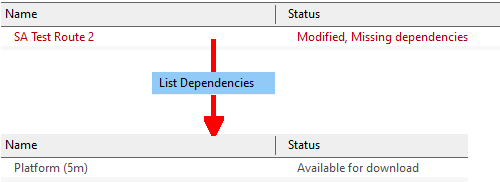 |
In this case, the Missing dependency is shown as Available for download so it is on the DLS and can be installed to fix the problem. If there are several assets that are listed as Available for download, select and download them all.
If the Missing dependency is an <unknown asset> then it can be a much harder problem to solve. See the section  Unknown Asset above for possible remedies. Unknown Asset above for possible remedies.
|
|
This situation shown in the example above can occur if you have:-
- deleted the asset without realising that it is needed in other assets, such as a Route or a Session, or
- used the Import command to install the asset from a .cdp file or a content folder - Content Manager will not search for and install missing dependencies when you import an asset.
- If you have imported an asset from a .cdp or content folder and see the Missing dependencies label then:-
- right mouse click on the asset or assets with the missing dependencies and select List Dependencies
- select all assets marked as Available for Download, right mouse click and select Download
 |
To avoid the possibility of accidentally deleting an asset that is a dependency of other assets:-
- right mouse click on the asset to be deleted
- select the command List Dependants
This will give a list of all other assets that use the selected asset.
Deleting the selected asset ("Abuttment 2" in the example shown) will produce Missing dependencies errors for all the assets shown in the Dependants list.
|
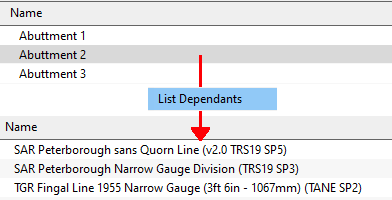
|
|
|
Trainz Wiki
 |
More Tutorials and Guides to Using Trainz
|
This page was created by Trainz user pware in January 2022 and was last updated as shown below.

Deleting Stubborn Scenery Assets.

Modifying and Sharing Payware below.
Missing Dependencies section below.
Missing kuids? Post them here











